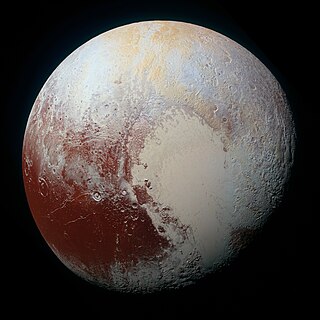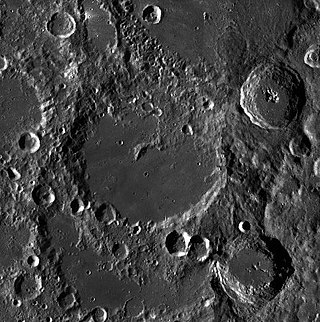
Planetary nomenclature, like terrestrial nomenclature, is a system of uniquely identifying features on the surface of a planet or natural satellite so that the features can be easily located, described, and discussed. Since the invention of the telescope, astronomers have given names to the surface features they have discerned, especially on the Moon and Mars. To found an authority on planetary nomenclature, the International Astronomical Union (IAU) was organized in 1919 to designate and standardize names for features on Solar System bodies.

Cyrillus is a lunar impact crater located on the northwest edge of Mare Nectaris. Intruding into the northeast rim is the slightly larger, and younger crater Theophilus. To the south is another prominent crater named Catharina. Together these three craters form a prominent trio in the southeast quadrant of the Moon. To the northwest is Ibn-Rushd. Cyrillus is named after Saint Cyril of Alexandria, a 5th-century Patriarch and theologian.

Euclides is a small lunar impact crater located near the eastern edge of Oceanus Procellarum, about 30 kilometers to the west of the Montes Riphaeus mountains. The mare in the vicinity is devoid of significant craters, but to the west is an area of low rises. The crater is named after the Greek mathematician Euclid.

Atlas is a prominent lunar impact crater that is located in the northeast part of the Moon, to the southeast of Mare Frigoris. Just to the west is the slightly smaller but still prominent crater Hercules. Northeast of Atlas is the large crater Endymion.

Lansberg is a lunar impact crater on the Mare Insularum. It can be located by following a line south-southwest from Copernicus to Reinhold, then southwest to Lansberg. The crater has a high rim and a central mountain. There are terraces along the inner walls, and the tops have slumped to produce a sharp edge. This formation is not noticeably eroded, and there are no significant impact craters within the interior.

Apollo, also called the Apollo basin, is an enormous impact crater located in the southern hemisphere on the far side of the Moon. This formation dwarfs the large crater Oppenheimer that is located next to the western rim. The crater Barringer lies across the northern wall. To the southeast is the crater Anders, and Kleymenov is just to the east of the rim.

Von Kármán is a large lunar impact crater that is located in the southern hemisphere on the far side of the Moon. The crater is about 186 km (116 mi) in diameter and lies within an immense impact crater known as the South Pole–Aitken basin of roughly 2,500 km (1,600 mi) in diameter and 13 km (8.1 mi) deep. Von Kármán is the site of the first soft-landing on the lunar far side by the Chinese Chang'e 4 spacecraft on 3 January 2019.

Dollond is a small lunar impact crater that is located in the central region of the Moon, to the north of the crater Abulfeda. It was named after British optician John Dollond. Due west of Dollond is Anděl. Dollond is circular and cone shaped, with a tiny floor at the midpoint of the sloping interior walls.

Eckert is a tiny, isolated lunar impact crater in the northern part of the Mare Crisium. This crater forms a circular pit in the dark surface of the surrounding lunar mare. Just to the west is a wrinkle ridge in the mare surface, a feature that is prominent only under oblique lighting from the Sun. The nearest craters of note are Peirce to the west-northwest, and Picard to the southwest. Both of these craters lie in the Mare Crisium basin.

Chauvenet is a lunar impact crater that is located to the northeast of the prominent crater Tsiolkovskiy on the far side of the Moon. Less than one crater diameter to the northwest of Chauvenet is the crater Ten Bruggencate.

Nobile is a lunar impact crater that is located near the southern pole of the Moon. It was named after the Italian aviator and explorer Umberto Nobile by the International Astronomical Union (IAU) in 1994. It lies to the south of the crater Scott, along the western rim of Amundsen. Between Nobile and the southern pole lie the smaller craters Shoemaker and Faustini.

Dobrovolʹskiy is a small lunar impact crater on the Moon's far side. The northwest part of its rim is intruded upon by the somewhat larger crater Shirakatsi, and the outer rampart of that feature covers most of the interior floor of Dobrovolʹskiy. Very little of the original floor now survives, with a small section near the southern inner wall. The remainder of the crater rim is somewhat circular and only mildly worn.

Mandelʹshtam is the remains of a large crater on the Moon's far side named after Leonid Mandelstam. Nearly attached to the northeast outer rim is the crater Papaleksi. To the south lies the crater Vening Meinesz.

Konstantinov is a lunar impact crater that is located to the southeast of the Mare Moscoviense, on the far side of the Moon. To the west of Konstantinov is the smaller crater Nagaoka, and to the south-southeast is the small Van Gent.

Shirakatsi is an impact crater that is located on the Moon's far side. It is attached to the southern exterior rim of the larger crater Perepelkin, and overlies the northwestern rim of Dobrovol'skiy.

Schiaparelli is an impact crater on Mars, located near the planet's equator at latitude 3° south and longitude 344° in the Sinus Sabaeus quadrangle. It measures approximately 459 kilometers (285-miles) in diameter and was named after Italian astronomer Giovanni Schiaparelli, known for his observations of the Red Planet and his mistranslated term "canali". The name was adopted by IAU's Working Group for Planetary System Nomenclature in 1973.

Kuiper is a moderate-size crater with a central peak cluster located at 11.35°S 31.23°W on Mercury. It is 62 kilometers in diameter and was named after Dutch-American astronomer Gerard Kuiper in 1976. It is one of only 2 Mercurian craters which are named not after artists, and one of very few cases when the same name is used for 3 craters. Gerard Kuiper, being a leader of American planetary science, died shortly before the first images of Mercurian surface were made.

Hovnatanian is a crater on Mercury. Its “butterfly” pattern of ejecta rays were created by an impact at an even lower angle than that which formed neighboring Qi Baishi crater. From the "butterfly" pattern of rays, the Hovnatanian impactor was travelling either north-to-south or south-to-north prior to hitting Mercury's surface. Hovnatanian lies to the west of Tir Planitia.

North Ray crater is a small crater in the Descartes Highlands of the Moon visited by the astronauts of Apollo 16. The name of the crater was formally adopted by the IAU in 1973. It is the largest crater sampled by astronauts during the Apollo program.

Sharp-Apollo crater is a small crater in Oceanus Procellarum on the Moon. The name of the crater was formally adopted by the IAU in 1973.





















